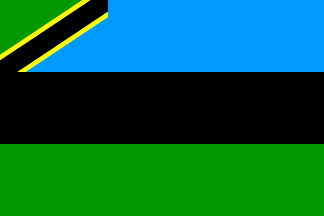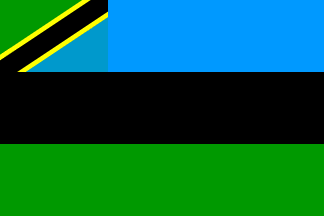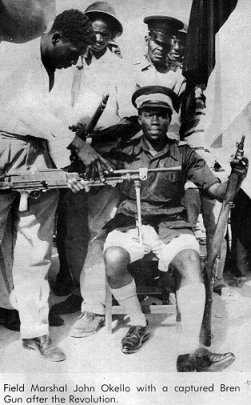 image
by Pascal Gross, 12 Jan 2005
image
by Pascal Gross, 12 Jan 2005
Last modified: 2022-10-22 by bruce berry
Keywords: zanzibar | president |
Links: FOTW homepage |
search |
disclaimer and copyright |
write us |
mirrors
 image
by Peter Hans van den Muijzenberg, 24 Aug 2007
image
by Peter Hans van den Muijzenberg, 24 Aug 2007
(Editor's note: the photo on that webpage shows only one shade of blue)
It seems (according according the photo shown) that the Tanzania flag
was "added" or "embroided" over the a original tricolor.
Manuel Gabino, 12 Jan 2005
Zanzibar seeks separate flag
:
Zanzibar's constitution allows it to have its own emblem. Zanzibar's
government has announced that the island will have its own flag by the
end of this year. Minister Salum Juma Osman told parliament that a new
emblem would give the semi-autonomous Tanzanian island its own identity.
He said the constitution "empowered the government to have its own identity",
and now was the appropriate time. Zanzibar has been using the flag of Tanzania
since its union with the former Tanganyika in 1964. Mr Osman told the BBC's
Focus on Africa programme that he did not feel the union government would
object to the plan. He said the government was planning to ask designers
and Zanzibaris to recommend a suitable design and colours for the flag.
Source: The Africa Travel & Tourism Association in the UK.
Alastair McKenzie, 02 Apr 2004
A news report today refers to a new flag for Zanzibar to be "officially
inaugurated in a few weeks' time." The new flag is described as blue, black and
green with "an insert of the Union flag".
It seems the new flag has still not been legally adopted.
Jan Oskar Engene, 21 Sep 2004
This seems to be similar to the "traditional" flag of Zanzibar, eg.
shown in [smi82] that only adds a very
thing white vertical stripe along the hoist. This remained the flag of Zanzibar even after the
formation of Tanzania, as far as I understand, but I do not know what is
its status today. The article seems to imply that there is some flag used
currently.
Also, it may be that the "hastily" journalistic style ignored the white
stripe and that we are talking of the same flag - that might be only now
officially (re)adopted. It is not at all clear how the "union" shall be
included in the canton, but surely this is what we understand from the article - right? However, there are enough possibility
for variations of this design that may more or less
equally match the description.
Željko Heimer, 21 Sep 2004
 image
by Pascal Gross, 12 Jan 2005
image
by Pascal Gross, 12 Jan 2005
There is some discrepancy on whether there are two shades of blue on the top
stripe or not. The description and images shown on
http://zanzibar.net/zanzibar/flag
has indicates two shades although it might be that in practice only one shade is
actually used.
Željko Heimer, 23 Aug 2007
There is the text of the Zanzibar Flag Act No. 12 of 2004 at World
Intellectual Property Organization (WIPO)
site.
Unfortunately, the pdf does not include the drawing in its Schedule. The
Act was passed on 11 October 2004 and was valid from 12 November 2004.
Željko Heimer, 05 Feb 2012
Britain attempted to shape the institutions. In 1914, a "Protectorate Council" was created under the nominal presidency of the sultan. The Council was composed of representatives of the colonial power and councillors of the sultan. The duty of the Council was the interior affairs of the country. In 1926, an Executive Council and a Legislative Council were set up, but the Africans were excluded from these Councils until 1945. The educational and economical system preserved, anyway, the privileges of the Arab minority, supported when required by the Asians of Indian origin who controlled the economy of the country.
After the Second World War, London pushed multi-community policies. Two Africans were appointed members of the Legislative Council. The Coutts Commission proposed the election of half of the members of the Legislative Councils, called "non official" by a unique electoral college. This reform was adopted in 1956. during the 1957 election, marred by violence, there was a burst of African nationalism. During the last years before independence, the struggle between the Arabs and the Africans was stronger and stronger. Constitutional Commissioner Sir H. Blood proposed a system based on a government responsible to a (mostly) elected Legislative Council. However, the January 1961 election did not yield a clear majority and a new election, once again marred by violence, was organized.
The problems of the representitivity of the elected chamber and the role allocated to the Arab minority were not solved when the independence of Zanzibar was proclaimed on 10 December 1963. The population of Zanzibar and Pemba was then 400,000 and the political life was extremely confuse. Before the Second World War, a few associations with a very limited audience had been created: the African Association (1934) represented the immigrants of continental origin and were closely linked to Nyerere's TANU; the Shirazi Association (1939) represented the Shirazi, mostly in Pemba; the Arab Association and the Indian Association represented the Arab and the Indian minorities, respectively. Real political parties were organized during the ten years before independence. The Zanzibar Nationalist Party (ZNP) was founded in 1956 by the Arabs and attempted to divide the community of African origin. The Afro-Shirazi Union had an opposed agenda. Sheikh Abeid amani Karume, president of the African Association and later of the Afro-shirazi Union (1957) promoted the creation of the Afro-Shirazi Party (ASP), struggling against both the colonization and the sultan. In 1959, autonomist Shirazis from Pemba founded the Zanzibar and Pemba People's Party (ZNPP). The ZNP was divided in 1963 when Abdulrahman Mohamed Sheikh "Babu" founded the Umma Party, rejecting the Islamic orientation of the ZNP and promoting the values of the Chinese and Cuba revolutions. The ASP won the January 1961 elections in Zanzibar but was competing in Pemba with the ZNPP. The ZNP, in spite of a very favourable electoral system, could not win the absolute majority. In the next election, in June 1961, the ZNP attempted to rally the ZNPP, to no avail.
On 12 January 1963, few days after the independence, an insurrection broke out and overthrew the sultan and his constitutional monarchy. The plot was conducted by Karume and his allies from outside Zanzibar, for instance "Field marshal" John Okello. Britain could not interfere and the local police was very weak, due to the sacking of several of its members a few days before after the suppression of the Umma Party by the sultan. Sultan Seyyid Ben Abdullah fled and a Revolutionary Council was set up by the ASP and the Umma Party, immediately proclaiming the "People's Republic of Zanzibar and Pemba", presided by Karume. Babu's Umma Party was rapidly excluded from the government dominated by the single ASP.
On 24 April 1964, following a meeting with the progressives and Pan-Africanist, Julius Nyerere, the "Republic of Tanganyika and Zanzibar" was proclaimed. A few months later, its name was changed to "United Republic of Tanzania". A provisional Constitution was passed on 10 July 1965, and remained in use until 1977. Zanzibar kept its own institutions, including the Revolutionary Council, its own party, budget and justice. Karume exerted absolute power and no election was organized until his assassination in 1972. Therefore, the "Union" had no reality, but Nyerere decided to handle Karume carefully in order to avoid a clash.
In 1977, the two unique parties TANU and AFS merged into the Chama Cha Mapinduzi (CCM), presided over by Nyerere. The Constitution adopted on 26 April 1977 was modified in October 1984. Zanzibar kept its president and vice-president, as well as its autonomous legislative system. The president of Zanzibar shall be first vice-president of the republic if the president of the republic is from the continent. Zanzibar is represented by 10 elected deputies, 32 deputies appointed by the Revolutionary Council and another 15 appointed by the president. The Constitution of Zanzibar, drafted by president A. Jumbe, was approved on 12 October 1979 by the Revolutionary Council and confirmed on 28 December by the National Conference of the CCM. Accordingly, the president of Zanzibar shall be elected by universal suffrage.
In spite of the unification of the parties and the autonomous statutes
of Zanzibar, secessionist feelings remained strong in Zanzibar. President
Jumbe resigned in January 1984 and was succeded by A.H. Mwinyi, elected
in April. The political crisis was mostly caused by the decline of the
clove trade and the struggle between Pemab and Unguja (the main island
with Zanzibar as its capital city). A. Wakil, officially appointed by the
CCM, was elected president on 13 October 1985 with a very narrow mergin.
He appointed his main rival, S.S. Hamad, from Pemba, as prime minister.
In the beginning of 1988, the president suspended the government and the
Revolutionary Council and proclaimed himself chief of the "Revolutionary
Special Forces of Zanzibar". In March 1989, Nyerere warned the secessionists
and stated that the Union would not be discussed.
Source: Encylopaedia Universalis.
Ivan Sache, 07 Apr 2004
Zanzibar was separated from Oman in 1861, and effectively controlled by Britain after 1873 when the Royal Navy enforced the closure of the slave market, and enlarged its base in the harbour from which it operated patrols against slave traders.
1885. Germany claimed administrative responsibility for Zanzibar, presumably on the grounds that both the main islands, Zanzibar and Pemba, lay off the coast of German East Africa, parts of which had previously been included in the Sultan of Zanzibar's mainland territories.
1890. Treaty of Berlin signed on 01 July. Germany withdrew her claim over Zanzibar and Witu (Sultan's mainland territories occupied by Britain), in exchange for Heligoland. Britain declared Zanzibar a British protected state.
There was no special British flag associated with Zanzibar at this time, as Zanzibar was the responsibility of the Foreign Office. It was transferred to the Colonial Office in 1914 and the Resident's flag introduced in 1918.
1918 amendment to 1916 Admiralty Flag Book: Zanzibar. Dhow, red
flag at stern, imperial crown above.
Naval Letters 9075/18 and 31236/18.
1925 amendment to the 1916 Admiralty Flag Book.
Listed all badges, the flags on which they appeared, whether there
was a garland if the badge appeared on the Union Jack, and whether there
was a white disc if on an ensign.
Only reference to Zanzibar was: "British Resident Zanzibar : on Union
Flag with garland."
1959 edition of "Observers Book of Flags"
by I.O.Evans
[eva59]:
"The Standard, Ensign and Merchant Flags of Zanzibar are plain red,
but the badge of the British Resident, placed at the centre of the Union
Flag depicts a dhow at sea; above is the Royal Crown."
1959 edition of "The Flag Book"
by Preben Kannik [kan59]:
"624a. British Resident in Zanzibar. Only used in the Union Flag."
David Prothero, 14 Jul 2002
![[Zanzibar 1964]](../images/t/tz-za64a.gif) image
by Mark Sensen, 03 Jun 1997
image
by Mark Sensen, 03 Jun 1997
Following the 17 January 1964 coup which deposed the Sultan, the revolutionary
group purporting to represent the island’s Negro majority proclaimed a
Peoples’ Republic. This immediately made an offer of union with the Marxist-leaning
government of Tanganyika. Two flags emerged during
the early part of this period - the horizontally striped black-yellow-blue
flag appears to have been short lived, and was replaced with the blue-black-green
triband with a white stripe in the hoist.
Stuart Notholt, 29 Jun1996
 image sent by Mikhail Revnivtsev, 26 Feb 2010
image sent by Mikhail Revnivtsev, 26 Feb 2010
On the Zanzibar Unveiled
website,created by Torrence Royer, there is an article called The Nine Hour
Revolution about the Zanzibar Revolution in 1964 with photo of its leader
"field marshal" John Okello with a black-yellow-light blue flag.
However, I think, that it is most likely that the black, yellow and light blue
striped flag was not a national flag of the People's Republic of Zanzibar and
Pemba, but probably was the flag of the Freedom Military Force (FMF) which was
created after 12 January bloodless revolution led by field marshal Okello.
In March 1964 the FMF was disarmed by Karume's supporters and the Umma Party
militia as described
here.
Mikhail Revnivtsev, 26 Feb 2010
![[Zanzibar 1964]](../images/t/tz-za64b.gif) image
by António Martins, 24 Oct 1998
image
by António Martins, 24 Oct 1998
As happened in neighbouring Tanganyika, this
latter flag was based on the emblem of the ruling party; in Zanzibar’s
case the Afro-Shirazi party. The party had a
flag of blue over black over green with a yellow hoe in the centre. The
national flag omitted the hoe and had a white stripe at the hoist.
Stuart Notholt, 29 Jun 1996
The white stripe is 1/36 of the length of the flag. Source: [bar65]
Mark Sensen, 03 Oct 1998
The flag is still being used by the Zanzibari football (soccer)-team.
Chrystian Kretowicz, 05 Apr 2004
![[Flag of Tanzania]](../images/t/tz.gif) image
by Željko Heimer, 08 Feb 1996
image
by Željko Heimer, 08 Feb 1996
Recently elections were held in Tanzania. In Zanzibar the CUF (main state opposition but de facto Zanzibar independen party) won the majority but elections were annulled by the state of Tanzania. I found some news about the flag of CUF (unknown to me).
Zanzibar police removing CUF flags and posters - Wednesday, January
26, 2000
By PST Correspondent, Zanzibar
Police in Zanzibar have launched an operation to remove Civic United
Front (CUF) flags and posters in Zanzibar Municipality.
A survey conducted by PST here has revealed that the police operation
also including municipal askaris, started last week and has reportedly
been succeeding. Policemen armed with firearms and wielding batons supervised
the removal of the flags, placards and pictures of CUF leaders in the opposition
party's Mji Mkongwe stronghold. Tables and flowers with posters containing
praises for the Commonwealth Secretariat brokered political agreement between
CUF and CCM in the Isles were also removed. The operation continued at Mbuyu Taifa area where
the municipal crane was used to remove CUF flag hoisted over 15 metre on
a baobab tree. The Director of the municipal council, Mr Musa Juma, acknowledged
that the exercise was going on but added that it had nothing political, but
aimed at cleaning the town. He added that the posters had been installed
without a permit from his office. Stalls at Darajani area were also being
demolished, although PST survey has shown those belonging to ruling party (CCM) youth, popularly called
`maskanis' and container-type stalls installed by some businessmen were
spared. As a result of the campaign, cheap fried potatoes are not there
any more. PST investigation has also found out that life of over 150 families
of the petty traders here is clearly uncertain as their bread winners had
their stalls demolished. People here are anticipating an increase in the
wave of banditry following the demolition of stalls and the existing lack
of comprehensive employment strategy in the Isles.
Jaume Ollé, 31 Oct 2000
![[Zanzibar President's flag]](../images/t/tz-zapr.gif) image
by Jens Pattke, 03 Feb 2005
image
by Jens Pattke, 03 Feb 2005
The president's flag of Zanzibar carries the seal of
the president on a green cloth. Over the emblem of the revolutionary government
is the yellow letter "R" for the KiSwahili word "Rais" (= president).
The inscription of circle band is "Nembo ya Rais wa Zanzibar"
(= the seal of the president of Zanzibar).
Jens Pattke, 14 Jan 2005
Here is a link
to a good-definition photo of the Zanzibari government web-site showing
a "podium" with the Zanzibar President's seal.
You will see in the lettering surrounding the emblem only reads in
capital letters: "Rais wa Zanzibar". Maybe the emblem is used like
this in the flag. The branches surrounding the letter "R" above
the shield are gold.
Juan Manuel Gabino Villascán, 02 Feb 2005
![[Republic of Pemba (1964)]](../images/t/tz_pemba.gif) image sent by Barghash Barghash, 01 Feb 2005
image sent by Barghash Barghash, 01 Feb 2005
This is the flag of the short-lived People's Republic of Pemba in 1964.
Any further info would be appreciated.
Barghash Barghash, 01 Feb 2005
Pemba was and apparently still is the world's main cloves producing
area.
historic data:
bf.1550
Pemba Island state established.
1606
Conquered by Malindi, later by Muscat and Oman.
c.1750
Rulers (diwani) established under Omani, later Zanzibari, sovereignty.
c.1865
Rulership extinct.
18 Jan 1964 - Jan 1964 Pemba People's Republic
Source: Franc van Diest's
website,
Jarig Bakker, 01 Feb 2005